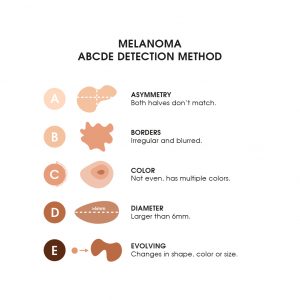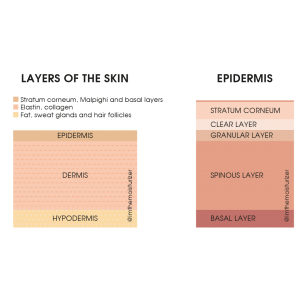Are you worried about skin spots and blemishes? Do you have hyperpigmentation or hypopigmentation? There are different cosmetics (like vitamin C, retinoids, azelaic acid…) that may help you improve your skin spots, but they all may not be what your skin needs. I’ll show you the best skincare products to reduce your skin spots!
Hello! Today, finally, I am going to talk to you in depth about skin spots. Or, rather, hyperpigmentation and hypopigmentation. This is a fairly complex topic and it is not always easy to find accessible and understandable information, but with this article I hope you can learn to identify if you have spots on your skin, which kind they are and what you can do to improve them.
Specifically, the points that I am going to discuss in this article are the following:
- Hyperpigmentation and hypopigmentation: what types of spots are there?
- Basic steps to improve spots.
- Advanced solutions to improve spots.
- What to do if you don’t know how to deal with the spots on your skin.
1. HYPERPIGMENTATION AND HYPOPIGMENTATION: WHAT TYPES OF SPOTS ARE THERE?
Although this is a complex topic and it can be easy to overload yourself with technicalities, I will try to shorten it and be as clear as possible.
Hyperpigmentation and hypopigmentation are possible responses of your skin to a harmful stimulus, such as ultraviolet radiation, the invasion of certain types of bacteria, or a negative reaction to a medication. Our body responds to this stimulus by generating what is known as reactive oxygen species (ROS), a name used to refer to a certain type of molecule and free radicals. The appearance of these molecules, which damage the structure of our skin, serves as a warning for cells (melanocytes) to come into action by producing melanin, a compound capable of absorbing more than 99.9% of UVB radiation. to which our skin is exposed.
When an excess of melanin is produced, we are upon what we know as hyperpigmentation. If our melanocytes are reduced or they are unable to produce melanin, we are faced with a case of hypopigmentation. To explain it plainly: if your spots are darker than your skin color, you are facing a case of hyperpigmentation, but if they are lighter than your skin color, it will be hypopigmentation.
There are many types of hyperpigmentation and hypopigmentation, and it is not always easy to understand what is your case. Also, depending on your phototype, there are certain types of spots that are more frequent than others. The phototype, if you did not know it, is determined based on a scale (Fitzpatrick scale), which establishes six types of skin (from lightest to darkest) based on how it can be estimated that these will respond to ultraviolet radiation.
Below, I will briefly explain what each of these types of spots consists of and what you can do to improve them in a specific way, although later I will indicate certain general recommendations that are beneficial in a common way to prevent and improve stains. Of course, you already know that this explanation is not a substitute for the evaluation that your dermatologist can make, he/she is the expert that you should always turn to for these problems.
MELANOMA:
Before going into detail about the types of hyperpigmentation and hypopigmentation, I want to stop for a moment to talk about a serious skin disease: melanoma.
It is important to keep in mind a general consideration: if you have a spot that is new, irregular, that has darkened, changes shape or looks strange, the importance of going to your doctor is even more crucial. They are the usual symptoms of melanoma (the most severe form of skin cancer), which arises when melanocytes begin to multiply uncontrollably, with genetic predisposition and exposure to ultraviolet radiation as the most common causes. That is why I insist so much on the importance of using sunscreen on a daily basis, since it protects us against this radiation and significantly reduces the risk of suffering from this disease.
Melanoma (as well as other forms of skin cancer) is a very harmful disease and can lead to very serious complications, so do not hesitate to go to a specialist if you consider that any spot has the characteristics I have mentioned, health always comes first.

TYPES OF HYPERPIGMENTATION:
Postinflammatory hyperpigmentation (PIH).
These types of spots appear, as their name suggests, as a consequence of some type of inflammation or injury (some common causes are acne, eczema or laser therapy) and are more common in people with high phototypes (darker skin). They are irregular in appearance and look as dark spots that can last for several years.
The best way to treat post-inflammatory hyperpigmentation in a specific way is by combining different therapies, for which you should go to your dermatologist and advise you about the various treatments available. For your part, you can improve it through your skincare routines by incorporating retinoids or certain acids such as azelaic, salicylic and glycolic.
Melasma and chloasma.
The most common causes of melasma are pregnancy (in these cases it is called chloasma) and the use of oral contraceptives. It is much more common in women than in men (90% of people with it are women), and it is also more frequent in high phototypes. It can be identified because they are well defined brown or grayish spots, usually symmetrical. They commonly appear in the center of the face, although they can occur anywhere else on the face.
The specific treatment for melasma that gives the best results is what is known as triple combination therapy, so you should go to your dermatologist to assess the best way to deal with it.
Solar lentigines.
Solar lentigines appear as a consequence of exposure to ultraviolet radiation, and usually occur in the arms, hands, back and chest. They are small spots between 1 and 3 centimeters in size and yellowish or brown in color. They are more frequent in the lower phototypes.
The most effective specific treatments to reduce solar lentigines are hydroquinone, retinoids and triple combination therapy. These types of spots can proliferate and spread very quickly, so if you think that it may be your case, visit your dermatologist as soon as possible to evaluate them and indicate the best treatment to follow.
Freckles or ephelides.
Freckles are perhaps the most recognizable type of spot. They are small (between 1 and 2 millimeters) and their color varies between red and brown. They usually appear in childhood, after exposure to ultraviolet radiation. Depending on their size, we can distinguish them from solar lentigines, which appear later and due to a greater presence of melanocytes.
Although they are asymptomatic and without risk, they can be improved by using certain acids in your routines, such as azelaic or glycolic acid.
Cafè au lait macules.
These spots are usually light brown in color and range in size from 1 to 20 centimeters. They usually appear on the trunk, and about 10-30% of the population has some kind of them.
Although they are not problematic, if several spots of this type appear, there may be a link with other diseases, so you should immediately go to your dermatologist to analyze them. Some possible treatments are laser therapy or surgery.
TYPES OF HYPOPIGMENTATION:
Postinflammatory hypopigmentation.
As with post-inflammatory hyperpigmentation, this form of hypopigmentation arises as a consequence of previous injury. It usually appears as a result of other types of hypopigmentation or other skin conditions such as psoriasis or atopic dermatitis. Depending on the cause that causes it, it can appear as macules or patches of different sizes and lighter in color than skin tone.
There are certain prescription treatments, such as corticosteroids, that provide effective results to reduce it.
Vitiligo.
Vitiligo is a very characteristic type of spot that appears as very well defined macules or patches of light color and sizes ranging from 5 to 50 millimeters. It can occur in an isolated or generalized way, depending on how widespread it is in the body. It usually appears on the face, arms, neck and many other areas of the body, and its exact origin is unknown, although genetics (as well as the immune system) plays an important role in its appearance. Normally it begins to occur between 20 and 40 years. It affects all phototypes.
There are several specific treatments that have shown positive results, all obtained with a prescription, such as certain corticosteroids. However, it is also common for treatments to fail and for this condition to become chronic.
Pityriasis alba.
This type of hypopigmentation can be identified because it generates irregular and hypopigmented patches that often feel itchy or flakey when they arise. It is more frequent in children and adolescents. It usually occurs on the face and neck and its appearance is usually associated with having suffered from atopic dermatitis and exposure to ultraviolet radiation.
Although no specific specific treatment is needed, there are certain types of prescription treatments that can help.
Tinea versicolor.
This is another type of pityriasis caused by a fungus. It can be identified because it causes thin plaques or scaling that is hypopigmented or pinkish in color. The most common areas where it appears are the neck, chest, abdomen, back and extremities, and sometimes it can appear as hyperpigmentation.
It is necessary to examine this type of stains to assess if, indeed, the presence of the fungus is what caused them and, in such case, they will be treated with a prescription.
2. BASIC STEPS TO IMPROVE SPOTS.
As you have seen, there is a wide variety of spots, with different causes and treatments dedicated to improving them. I want to reiterate the importance of going to your dermatologist to evaluate your spots and determine if they may be the cause of more serious damage to your skin or body.
In any case, there are certain steps we can all take to improve (or sometimes prevent) spots. Naturally, these measures have their limitations and, although they will always be helpful, it is likely that you will require a specific dermatological treatment prescribed by your doctor.
Keep in mind that a crucial aspect to improve stains is their degree of penetration. This implies that the deeper a stain, the more difficult it will be to remove. In fact, stains with higher penetration cannot be solved with cosmetics.
However, if you have just observed a spot of recent appearance, there is still time to act to prevent it from getting worse and to improve it. Keep in mind that, usually, as with everything related to our skincare routines, patience and perseverance are essential to obtain the results we seek. It may take several weeks or months to see an improvement in your spots, but don’t despair.
The 3 basic steps you can take to prevent or improve blemishes are the following:
Sunscreen.
You know that I am very insistent in relation to sunscreen, it must be used daily, without exceptions, regardless of whether you are at home or if the weather is cloudy or rainy. In addition, you must remember that it is important to reapply it to ensure that you provide your skin with the necessary protection against ultraviolet radiation.
If you have spots or want to prevent them, sunscreen is not an option, it is an obligation. Its use helps to improve most types of hyperpigmentation and hypopigmentation that I mentioned above, in addition to melanoma (which, as you will remember, has a close relationship with exposure to ultraviolet radiation).
The minimum protection that your sunscreen should give you is SPF 30, although if you already have spots it is better to use one with SPF 50+ and PA ++++ (or broad spectrum, since you already know that SPF only refers to protection against UVB radiation, but we must also protect ourselves against UVA radiation).
I am aware that there are many sunscreens on the market and it is not always easy to find one that suits what you are looking for, so here you can see my comparison of sunscreens, in which you will surely find one that fits your needs.
Moisturizing.
Remember the basic steps of all skincare routines? Hydrated skin is healthy skin. If we are concerned about any aspect of our skin (such as spots), it is extra important to keep our skin healthy and in perfect shape, since otherwise we will not be able to allocate enough resources to improve these concerns.
It is essential that you find a moisturizer that fits what you are looking for, since depending on your skin type (and your needs) there are certain ingredients that can give you more effective results than others. For example, if you have combination or oily skin it is convenient to use a light and moisturizing cream, like this Youth to the People Superfood Air-Whip Moisture Cream. On the other hand, if your skin is dry or very dry, you will be interested in looking for a majority of occlusive or emollient ingredients, as in the case of this moisturizer by Paula’s Choice, available on Paula’s Choice and on Niche Beauty.
Exfoliation.
Exfoliation can be key upon the recent appearance of certain types of spots. If you have a spot that has recently appeared and is superficial, exfoliating your skin correctly will allow you to improve the appearance of that blemish.
To understand how exfoliation can help you, we must be aware of the structure of the outer layers of our skin. The skin has three fundamental layers (from inner to outermost are the hypodermis, the dermis, and the epidermis). The stratum corneum is the most superficial section of the epidermis and is made up of a series of layers of dead cells on top of which is the skin barrier or acid mantle.

Steadily (although the rate decreases over the years), our skin goes through a process called cell turnover, in which the outermost layer of dead cells is shed, so that new layers appear on the surface of dead cells. What we achieve by exfoliating the skin is to remove the most superficial layer, thus allowing our skin to renew itself. This way, if you have observed a new spot on your skin and it is superficial, by exfoliating correctly you can get improve or even get rid of it.
I want to emphasize one important detail: you have to exfoliate correctly. This means that we should not abuse the exfoliants or use them too little, we must find a balance. You already know that I do not particularly like physical exfoliants (like scrubs or brushes), but I’d rather do a chemical exfoliation, since it is more respectful of the skin barrier and acts on deeper layers. If you want to know how to properly do a chemical exfoliation, you can read it in this other article.
3. ADVANCED SOLUTIONS TO IMPROVE SPOTS.
Now that you have seen the three elementary steps that can help you improve your spots, I want to take you one step further and show you some ingredients that can benefit you, as long as you incorporate them correctly into your skincare routines. I know that when you have a spot you look for all the possible solutions to get rid of it immediately, but you must be patient and constant. Do not think about doing a shock treatment with cosmetics, but about using them to progressively achieve the result you are looking for. Remember that there is no point in using the products that I am going to tell you about if you do not follow a basic skincare routine.
Vitamin C.
You probably know that vitamin C is undoubtedly one of my favorite ingredients in skincare. In fact, if you want to start incorporating it into your routines, I advise you to read this guide, in which I explain how to do it.
In addition to being a powerful antioxidant and protecting us against damage from ultraviolet radiation, vitamin C can also be of great help in improving the tone and texture of our skin, being a good ally in reducing spots. Not only does it enhance the results of other more powerful depigmentants, but vitamin C also inhibits the production of melanin, so it can help you avoid the darkening and worsening of that new small spot you have found.
If you want to start incorporating vitamin C into your beauty routines, I advise you to take a look at my comparison of vitamin C serums, in which you will surely find a product that fits your needs.
Niacinamide.
Niacinamide is another one of my reference ingredients. Not only does it help us to rebalance the oil levels of the skin (something that those of us with combination or oily skin are especially grateful for), but it also inhibits the process of melanogenesis, by which melanin is produced, so it will also be a good ally in your beauty routines.
If you want to use niacinamide, I especially like The Ordinary Niacinamide 10% + Zinc 1%, available on DECIEM (recommended) and this serum from Paula’s Choice.
Retinoids.
Some conditions that we have seen before that can be improved with the use of retinoids (specifically retinoic acid, which requires a prescription). Retinoids, which you can read more about here, accelerate that process of cell turnover that we have talked about before, so they can be a good solution for recent or superficial. However, if you are looking to reduce or improve a deeper stain, they may not provide you with the result you are looking for.
Hydroquinone.
Hydroquinone is undoubtedly the reference shock treatment for reducing spots. It is probably the best known ingredient, but it is very powerful and you have to know how to use it. In many countries it requires a prescription, and has significant side effects, so if you think you may need it, consult your doctor, who will be able to assess whether it really is the right treatment for you.
4. WHAT TO DO IF YOU DON’T KNOW HOW TO DEAL WITH THE SPOTS ON YOUR SKIN.
I am aware that skin spots are a worrying problem. Often, especially if they are visible, they can affect you a lot emotionally and our willingness to get rid of them is immense.
At first it can be difficult to correctly identify the type of stain you have, and it doesn’t matter how many images and articles you search on the internet, it is easy to be wrong. Self-diagnosis is never positive, so if you have just discovered a spots on your skin, the most effective solution to resolve any doubts is to go to your doctor, who will examine it and do any relevant tests to the tissue.
Remember that if you have an asymmetric stain, with irregular edges, with a heterogeneous color, a diameter greater than 6 millimeters or that has changed in shape, color, size or any other aspect, you may be facing a possible case of melanoma (skin cancer) and, therefore, it is essential that you go to your doctor.
With this article I want to help you better understand the different types of spots that exist, what are their causes and what solutions are in your hands (in addition to possible medical treatments). As you have seen, there are cosmetics that can help us improve the appearance of the spots on our skin, but remember that they require your perseverance and patience and that, sometimes, they will not give you the result you are looking for.
I would like to know a little about your cases. Do you have or have you had spots on your skin? What type? What treatment did you follow to improve them? Tell me in the comments section!
If you liked this article and want to continue learning to take care of your skin, be sure to read these other posts:
Do you want to learn to take better care of your skin? You can see an index of all my informative posts here.● Follow me on Instagram, Facebook, TikTok and Pinterest.
● Share, comment and like my posts on social media.
● Shop through my links to help me keep up with this blog.

I’m Nacho and I’m passionate about skincare. I really enjoy learning and sharing my knowledge about skincare and I read scientific papers so you don’t have to. I want to break stereotypes because I believe skincare has no gender: skin is skin.



Hola Nacho. Excelente tu artículo. Yo tengo la piel clara, creo que soy tipo 2 en la escala de Fitzpatrick. Tengo lentigos e pequitas. Como tengo el cutis graso no usaba protector solar frecuentemente cuando era más joven. Hace muchos años solo había bronceadores y bloqueadores, y la textura de los bloqueadores era horrorosa. Por dicha ahora hay productos más elegantes para proteger la piel. Ahora uso protector solar todos los días y productos para aclarar esas manchas en la piel. Más adelante me quitaré las que queden con láser.
Hola Ana, bienvenida a mi blog! 😊
Me alegro mucho de que hayas empezado a incorporar el protector solar a diario en tus rutinas de belleza. Es cierto que la cosmética ha avanzado mucho y cada vez es más fácil encontrar protectores solares muy eficaces y muy cómodos. Aquí puedes ver mi comparativa de protectores solares, por si todavía no has encontrado uno que se ajuste a lo que buscas 😉
Un saludo,
Nacho.